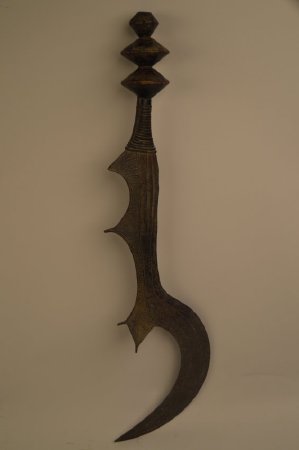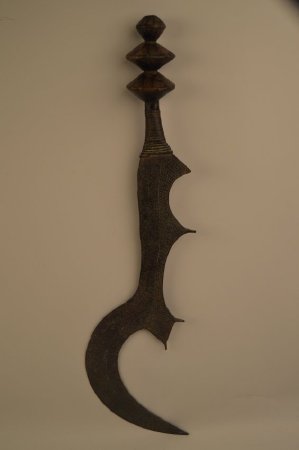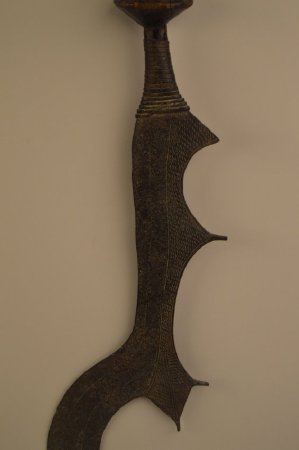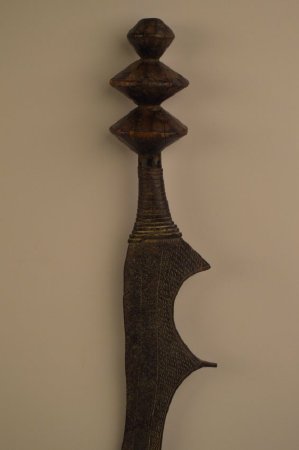Title:
Nagala Executioner's Sword
Object Name:
Sword, Executioner's
Other Name:
Sword, Executioner's
Place of Origin:
Kuba, Democratic Republic of Congo, Africa
Provenance:
Aboriginal Indigenous Art.
H = 30"
W = 7—1/2"
D = 3"
Knives, daggers and swords from the Kuba people are used as prestige items. Historical documents indicate that quantities of them were brought to the Congo by Portuguese and Dutch traders beginning around the 16th century. Many weapons were then forged by Congolese blacksmiths to emulate foreign examples. They were reserved for nobles and used for important ceremonial occasions.
This forged iron sword was probably used durning ceremonial excecution of a captured prisoner. There are several different varieties of designs. These knives were also used as currency. Both the Ngombe and Doko used the ngulu during the 20th century. The knife had transformed itself into a ceremonial dance blade. The reason for this was that by 1900 the Belgium's had forbidden executions, as well as cannibalism, equally widespread. Regardless, the Ngombe continued to use the cult knife in their "Likbeti" dance, which often lasted two days. At the end of the dance a goat was sacrificed for the feast, with a single stroke from the back side of the blade.
H = 30"
W = 7—1/2"
D = 3"
Knives, daggers and swords from the Kuba people are used as prestige items. Historical documents indicate that quantities of them were brought to the Congo by Portuguese and Dutch traders beginning around the 16th century. Many weapons were then forged by Congolese blacksmiths to emulate foreign examples. They were reserved for nobles and used for important ceremonial occasions.
This forged iron sword was probably used durning ceremonial excecution of a captured prisoner. There are several different varieties of designs. These knives were also used as currency. Both the Ngombe and Doko used the ngulu during the 20th century. The knife had transformed itself into a ceremonial dance blade. The reason for this was that by 1900 the Belgium's had forbidden executions, as well as cannibalism, equally widespread. Regardless, the Ngombe continued to use the cult knife in their "Likbeti" dance, which often lasted two days. At the end of the dance a goat was sacrificed for the feast, with a single stroke from the back side of the blade.
Description:
Long sickle—shaped blade with four pointed thorn—shaped edges, culminating into undulating edge. Three—knobbed handle wrapped in copper wire at the hilt, probably an executioner's blade.
Collection:
Finley Collection
Material:
Wood W/Iron and Copper
Used:
Ritually Used
Technique:
Metal Working / Carving
Owned:
Art Department, Missouri Southern State University
Accession#:
2014.1.115



